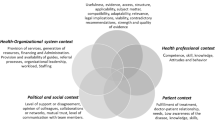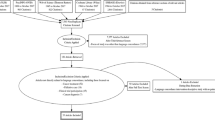Abstract
With the increasing use of complementary and alternative medicine (CAM) in the US, academic medical centres need to provide evidence-based CAM information and services. To develop a CAM programme involving practice, education and research at our tertiary-care academic medical centre, we initiated a four-pronged approach: (i) creation of an interdisciplinary CAM interest group, (ii) a survey of CAM use among 1514 patients seen at our institution, (iii) a survey of knowledge and attitudes toward CAM among 660 physicians in our institution’s Department of Internal Medicine and (iv) a pilot study of CAM consultations provided at no cost to 102 patients. Bringing together individuals from multiple disciplines across our institution resulted in numerous alliances and collaborations. We documented that many of our internists thought that addressing CAM therapies would improve patient satisfaction and that our patients used CAM therapies and found CAM consultations helpful. Our present programme is devoted to practice (a CAM consultation service has been implemented), education (medical school lectures and a postgraduate-level curriculum in CAM medicine have been developed) and research (there are several ongoing clinical trials).
Similar content being viewed by others
References
Eisenberg DM, Kessler RC, Foster C, et al. Unconventional medicine in the United States: prevalence, costs, and patterns of use. N Engl J Med 1993; 328: 246–52
Eisenberg DM, Davis RB, Ettner SL, et al. Trends in alternative medicine use in the United States, 1990–1997: results of a follow-up national survey. JAMA 1998: 280: 1569–75
Barnes PM, Powell-Griner E, McFann K, et al. Complementary and alternative medicine use among adults: United States, 2002. Adv Data 2004; 343: 1–19
National Center for Complementary and Alternative Medicine. What is complementary and alternative medicine (CAM) [online]? Available from URL: http://nccam.nih.gov/health/whatiscam/#4 [Accessed 2005 Jul 13]
Wahner-Roedler DL, Elkin PL, Lee MC, et al. Complementary and alternative medicine: use by patients seen in different specialty areas in a tertiary-care centre. Evid Based Integrative Med 2004; 1(4): 253–60
Straus SE. Complementary and alternative medicine: challenges and opportunities for American medicine. Acad Med 2000; 75: 572–3
Hensrud DD, Engle DD, Scheitel SM. Underreporting the use of dietary supplements and nonprescription medications among patients undergoing a periodic health examination. Mayo Clin Proc 1999; 74: 443–7
Acknowledgements
This paper was presented at the Society of General Internal Medicine (SGIM) 27th Annual Meeting in Chicago, Illinois, USA, May 12–15, 2004.
No sources of funding were used to assist in the preparation of this article. The authors have no conflicts of interest that are directly relevant to the content of this article.
Author information
Authors and Affiliations
Corresponding author
Rights and permissions
About this article
Cite this article
Wahner-Roedler, D.L., Elkin, P.L., Vincent, A. et al. Development of a Complementary and Alternative Medicine Programme at an Academic Medical Centre. Evid-Based-Integrative-Med 2, 9–12 (2005). https://doi.org/10.2165/01197065-200502010-00003
Published:
Issue Date:
DOI: https://doi.org/10.2165/01197065-200502010-00003




